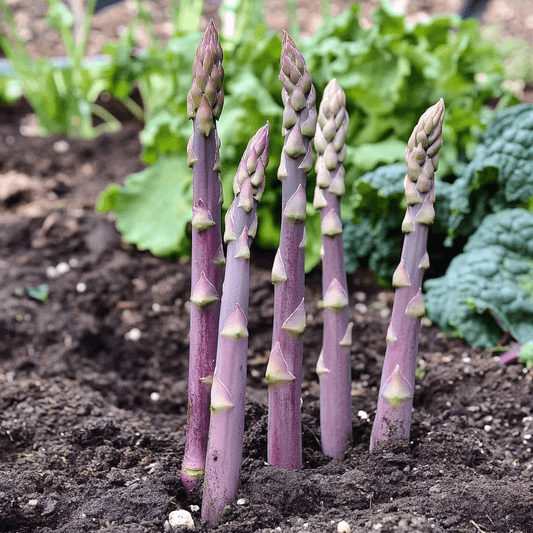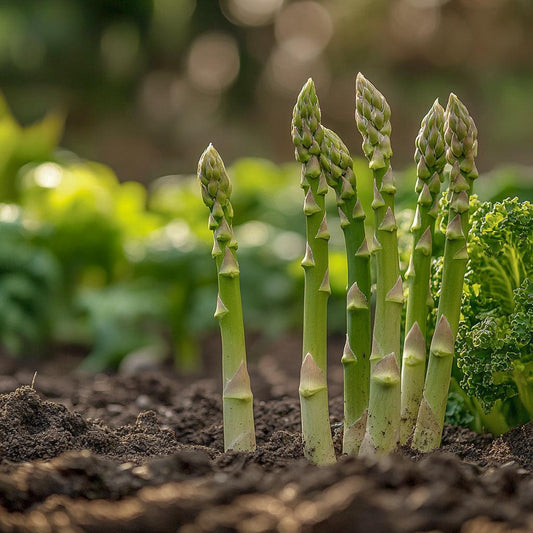Growing Asparagus
Growing asparagus is a valuable addition to any garden, offering delicious and nutritious spears year after year. This hardy perennial thrives in a variety of climates and rewards gardeners with long-lasting productivity. Understanding the nuances of planting and caring for asparagus plant roots ensures healthy growth and a thriving year asparagus bed for seasons to come. Whether you’re planting bare root asparagus crowns or choosing organic asparagus crowns, these plants flourish in full sun and well-drained soil within the appropriate hardiness zones. With proper spacing of 12–18 inches between crowns, you'll establish strong roots and vigorous plants. Explore our premium asparagus crowns for sale, including favorites like Jersey Knight, and start building your productive asparagus patch today!
Asparagus Crowns:
There are different types of asparagus, such as Purple Passion and Jersey Giant. These types have different tastes and can grow in different areas. The suitable growing zones for these asparagus varieties are zones 3-8. Choose high-quality asparagus roots or crowns from reliable sources for a thriving asparagus bed.
Asparagus Planting:
Plant asparagus roots in early spring or fall/winter for mild climates. Select a permanent location for the asparagus bed, as these plants can be productive for 15-20 years. Ensure loose, well-drained soil rich in compost to support root development.
Preparing the Bed:
Plant asparagus crowns in a trench approximately 12-15 inches deep, spaced about 18 inches apart. As the shoots emerge, gradually cover them with 2 inches of soil, repeating this process as the plants grow until the trench is filled to the top. Some sandy soils may work well if provided the correct level of nutrients.
Understanding the Root System:
Asparagus roots require ample space and depth for optimal growth. A well-prepared trench, adequately spaced, allows for proper root development, contributing to healthy asparagus plants.
Ample Space for Asparagus Roots:
Asparagus roots thrive when provided with abundant space and correct amount of water. To help plants grow well, ensure that the planting area has sufficient space for roots to spread and explore the soil. This will allow the plants to reach their full potential. This not only supports the immediate growth of the plant but also sets the stage for long-term vitality.
Optimal Depth for Asparagus Roots:
The depth of the planting trench is a critical factor in nurturing healthy asparagus roots. These roots prefer a well-prepared trench that extends to the ideal depth, allowing them to establish a robust foundation. Adequate depth promotes vertical growth, aiding the roots in accessing essential nutrients and moisture from the soil.
Soil pH and Maintenance:
Asparagus prefers a soil pH of around 6.5 to 7.5. To keep the soil fertile and provide plants with necessary nutrients, regularly add compost or manure. This will help plants thrive and live longer.
Initial Years of Growth:
During the first year, limit harvesting to a few spears, allowing most to develop into ferns. This process directs energy back into the roots, strengthening the plants. The year after planting, begin regular harvesting of the spears.
Harvesting Asparagus Spears:
Harvest asparagus spears by snapping or cutting them at ground level when they reach 6-8 inches tall. Regular harvesting encourages continuous spear production throughout the growing season.
Longevity and Care:
Asparagus crowns are long-lived, establishing a productive bed that requires minimal maintenance. Regular weeding, adequate watering, and mulching help maintain soil moisture and keep the bed healthy. With proper care and maintenance asparagus will provide a long term, year after year harvest.
Varieties and Passion for Asparagus:
Explore different asparagus varieties like Purple Passion, Jersey Giant, or others suited to your climate and taste preferences. Purple Passion, for instance, boasts a unique color and flavor profile, adding diversity to your harvest.
Bare Root Asparagus Crowns:
These crowns, sold in bundles, offer a cost-effective way to establish an asparagus bed. Careful planting and proper care ensure a thriving bed yielding abundant, flavorful spears.
Cultivating asparagus crowns demands attention to initial planting depth, soil quality, and patient care for the first couple of years. Growing asparagus in a garden gives tasty spears for a long time, making it a valuable addition to any garden.
Click here to access the complete Asparagus Growing Guide (PDF) for detailed information on soil preparation, planting, and long-term care.
For more information, enjoy our recent blog about Purple Asparagus.
 Sold out
Sold out




